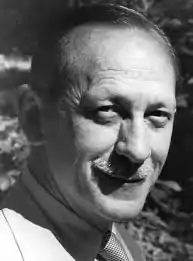Henry Sherwood Lawrence
Henry Sherwood Lawrence (September 22, 1916 – April 5, 2004) was an American immunologist best known for his discovery of transfer factors in 1949. [1] He is also known for being one of founders of the new branch of biology that explores the function of lymphocytes. [2] Lawrence was the head of the department of infectious diseases and immunology at New York University,[2] co-director of medical services at Bellevue and New York University Hospitals,[2] a member of the National Academy of Sciences,[1][2] director of New York University's cancer center,[1][2] the founding editor of the journal Cellular Immunology,[2] director of New York University's AIDS research center.[1][2] The New York Times called Lawrence "a pioneering immunologist", "an expert in infectious diseases" and said that "his research generated other advances in immunology".[2] The National Academy of Sciences called him "a distinguished physician, a master teacher, and a pioneer in research on cell-mediated immunity".[1]
Dr. Henry Sherwood Lawrence | |
|---|---|
 | |
| Born | Henry Sherwood Lawrence September 22, 1916 New York |
| Died | April 5, 2004 |
| Occupation | Immunologist |
Notable awards and distinctions
- The "von Pirquet Gold Medal for Scientific Advancement in Immunology from the Forum on Allergy".
- The "New York Academy of Medicine Medal for Outstanding Contributions to Science".
- The "American College of Physicians Award for Outstanding Contributions to Science".
- The "Lila Gruber Award for Cancer Research from the American Academy of Dermatology".
- The "Distinguished Teacher’s Award from the New York University School of Medicine".
Chronology
- 1916: Born in Astoria, Queens, New York City on May 22.
- 1938: Graduated from New York University.
- 1943: M.D., New York University.
- 1949: Joined the medical faculty of New York University.
- 1959–2000: Became "Head of Infectious Diseases and Immunology", New York University.
- 1964–2000: Named "Co-director of Medical Services" at Bellevue and New York University Hospitals.
- 1979: Assumed the "Jeffrey Bergstein Professorship" of Medicine at New York University.
- 2000: Retires.
References
- Al-Askari, Salah (2009). "Henry Sherwood Lawrence". Biographical Memoirs, National Academy of Sciences. Vol. 90. Washington DC: National Academies Press. pp. 237–255. ISBN 9780309121484.
- Altman, Lawrence K. (2004-04-08). "H. Sherwood Lawrence, 87, Immunology Pioneer". The New York Times. ISSN 0362-4331. Retrieved 2023-01-15.